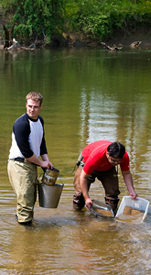Sedimentary provenance/detrital mineral geochronology
One of the fundamental goals of applying detrital mineral chronology to clastic sediments is to discern the identity of accreting terranes or continents, as well as constrain the timing of terrane collision, amalgamation and translation (e.g., Link et al., 2005). In effect, we seek to understand the tectonic history of an orogen by examining its eroded products For this to occur in an unbiased manner, however, requires that most of the crustal components available for erosion produced an amount of detritus at least generally proportional to the areal extent of the crust exposed. In other words, the assumption is made that if a large random selection of minerals is dated then an unbiased proxy of the amount of exposed crust of each specific age would be determined. That view may be valid in some circumstances, but there is increasing evidence that conventional U-P zircon dating does lead to significant bias (e.g., Moecher and Samson, 2006). For example, on the basis of currently available detrital zircon age databases from Appalachian Paleozoic sedimentary rocks, one would come to quite erroneous conclusions about the crustal makeup of the region following the above assumption. Most remarkably, the Alleghanian clastic wedges apparently contain no Pennsylvanian to Permian-aged zircons (Becker et al., 2005; Thomas et al. 2004). From the perspective of detrital zircon in the Alleghanian foreland, therefore, the Himalayan-scale orogeny resulting from Laurentia-Gondwana collision and the assembly of Pangea never occurred! Given the potential bias in relying on dating detrital zircon it is clear that new, additional techniques are needed.

We recently received NSF funding to explore the utility of detrital monazite in provenance studies. Our chronological work demonstrates that the ages of detrital monazite crystals produces a much ‘higher fidelity’ record of past tectonic events compared to detrital zircon from the same sediment (Hietpas et al., in review). And there is the possibility that even more provenance information is available in detrital monazite – the initial 143Nd/144Nd ratio of the crystal. Samson is well aware of the potential for age zonation in monazite, and in those cases whole-crystal Nd analysis would be of little value. However, U-Th-Pb dating via ion microprobe or electron probe (non-destructive techniques) is always performed first, thus multi-age monazite grains are screened and precluded from Nd isotope analysis (a point we apparently did not make adequately clear in the previous submission). We also note that the majority (> 75%) of the detrital monazite we have dated using the ion probe and electron probe are not age zoned and thus are excellent candidates for Nd isotopic study. Given the very high concentration of LREE within monazite it is not difficult to precisely measure Sm-Nd isotopic characteristics on single grains. This combined U-Th-Pb dating + Nd isotopic compositional approach holds great potential for extracting much more information about source regions than detrital zircon dating alone can accomplish.
